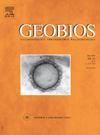谁是谁,为什么。奥古斯盆地考古带两个遗址牙印鉴定的意义西班牙南部)
IF 1.6
4区 地球科学
Q2 PALEONTOLOGY
引用次数: 0
摘要
鄂西盆地考古区;格拉纳达(西班牙)因其包含一些最重要的早更新世考古古生物遗址而闻名,这些遗址有助于了解欧亚大陆最西端最早的人类定居点及其生态环境。其中包括Venta Micena (VM)、Barranco León (BL)和Fuente Nueva 3 (FN3)。在OBAZ遗址中发现的已灭绝的Pachycrocuta brevirostris所扮演的角色早已在文献中得到认可。然而,对其他有记录的食肉动物物种的作用知之甚少。然而,3D建模、几何形态计量学、稳健数据建模和人工智能算法等技术的发展,使得描述一种牙印(坑)及其分类单元的特征成为可能。此外,这种方法的结合使我们能够推断出与食肉动物行为有关的新方面,建立VM3和BL食肉动物代理人之间的解释性区分,指出它们之间以及与人属的相互作用,并回顾一些关于人类首次向非洲以外扩散的建议。本文章由计算机程序翻译,如有差异,请以英文原文为准。
Who is who and why. Implications of tooth-marks identification at two sites in the Orce Basin Archaeological Zone (OBAZ; southern Spain)
The Orce Basin Archaeological Zone (OBAZ; Granada, Spain) is well known because it contains some of the most important Early Pleistocene archaeo-palaeontological sites for understanding the earliest human settlement in the westernmost part of Eurasia and its ecological context. Among those are Venta Micena (VM), Barranco León (BL) and Fuente Nueva 3 (FN3). The role played by the extinct Pachycrocuta brevirostris present at the OBAZ sites has long been recognised in the literature. However, little or nothing is known about the agency of the other documented carnivore species. Nevertheless, the development of technologies such as 3D modelling, geometric morphometrics, robust data modelling and artificial intelligence algorithms makes it possible to characterise a type of tooth mark (pits) and its assignment to a taxon. Moreover, such a combination of methodologies allows us to infer novel aspects related to the behaviour of carnivores, to establish interpretative differentiation between the carnivore agents at VM3 and BL, to point to the interactions among them and with Homo, and to review some proposals on the first human dispersal outside Africa.
求助全文
通过发布文献求助,成功后即可免费获取论文全文。
去求助
来源期刊

Geobios
地学-古生物学
CiteScore
3.30
自引率
6.20%
发文量
28
审稿时长
6-12 weeks
期刊介绍:
Geobios publishes bimonthly in English original peer-reviewed articles of international interest in any area of paleontology, paleobiology, paleoecology, paleobiogeography, (bio)stratigraphy and biogeochemistry. All taxonomic groups are treated, including microfossils, invertebrates, plants, vertebrates and ichnofossils.
Geobios welcomes descriptive papers based on original material (e.g. large Systematic Paleontology works), as well as more analytically and/or methodologically oriented papers, provided they offer strong and significant biochronological/biostratigraphical, paleobiogeographical, paleobiological and/or phylogenetic new insights and perspectices. A high priority level is given to synchronic and/or diachronic studies based on multi- or inter-disciplinary approaches mixing various fields of Earth and Life Sciences. Works based on extant data are also considered, provided they offer significant insights into geological-time studies.
 求助内容:
求助内容: 应助结果提醒方式:
应助结果提醒方式:


